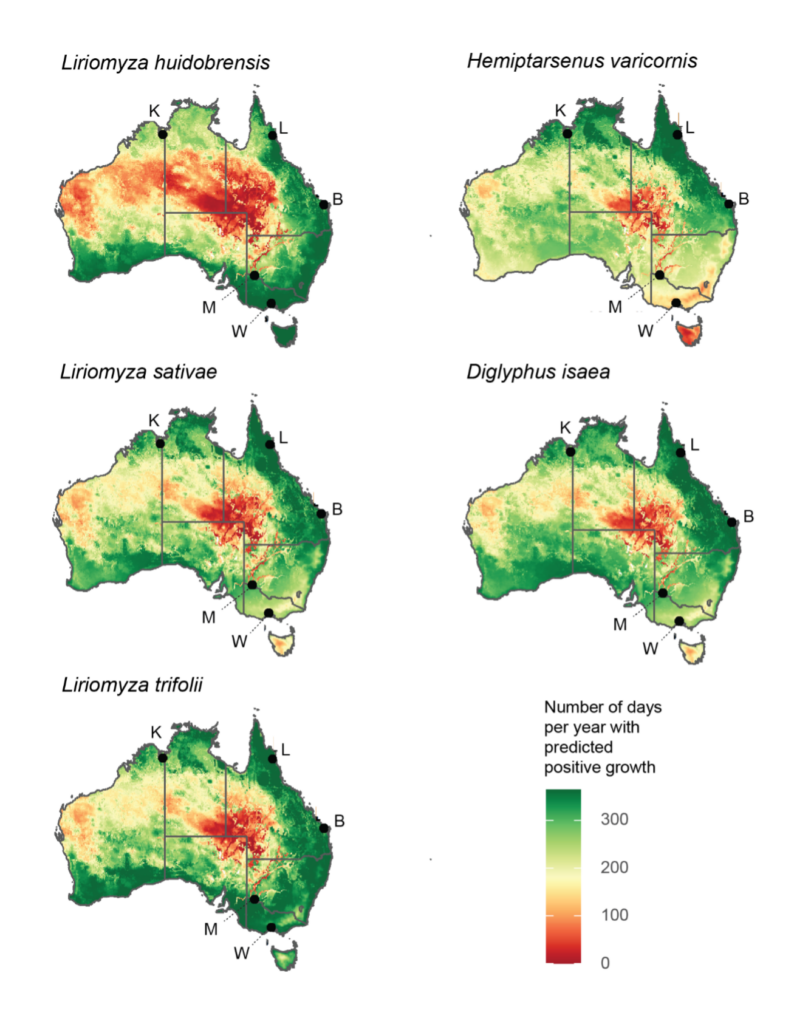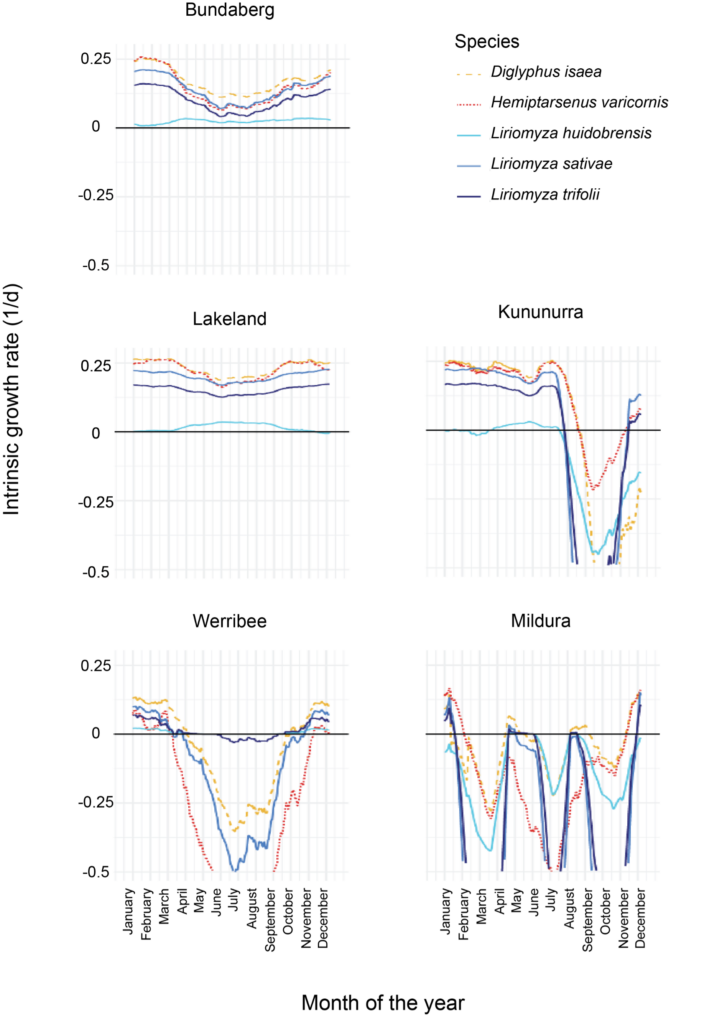In a new study, scientists have predicted the potential spread of three exotic species of Liriomyza leafminers—L. huidobrensis, L. sativae, and L. trifolii—that have recently invaded Australian crop production regions. These pests are known to cause significant damage to vegetable and nursery crops, with some instances of crop loss exceeding 50%. In many cases, the most suitable climates for pest establishment overlap with production periods for high-risk crops, exacerbating the potential damage caused by these invasive species.
Since its initial detection in NSW in October of 2021, L. huidobrensis has since been determined to be not technically feasible to eradicate, transitioning the response from quarantine to management. This pest is now considered established in New South Wales, Queensland and Victoria. L. sativae was detected in Queensland in 2015, and is under official control, whereas L. trifolii has been considered established in Queensland and northern Western Australia since 2021.
Importance of fostering leafminers’ natural predators
Fortunately, the study also highlights the potential for natural control of these leafminers through parasitism by parasitoid wasps, specifically Diglyphus isaea and Hemipyarsenus varicornis. These wasps have been recognised as effective biocontrols for Liriomyza species for over a decade. Researchers predict that these wasps will attack incoming Liriomyza populations where they co-occur in Australian agricultural regions.
However, these parasitoid populations, as well as other beneficial predators, are disrupted by the overuse of broad-spectrum insecticides. Leafminer pests typically only reach damaging levels after severe reductions in parasitoid numbers.
Forecasting spread
The potential distribution of L. huidobrensis, L. sativae, L. trifolii and their predators D. isaea and H. varicornis were each estimated in Australia based on population growth potential. This involved the compilation of empirical data on the temperature response of intrinsic population growth and the projected estimated population growth across the world via modern global climactic datasets. The predicted distributions of L. huidobrensis, L. sativae and L. trifolii were validated using available international occurrence data.
Along with the population growth potentials, population mortality from extreme conditions was also modelled, where thermal stressors were considered along with moisture stress.
Global population potential
Figure 1 depicts the large regions of Australia that are predicted to have climates capable of supporting positive population growth for all species considered. L. sativae and L. trifolii are anticipated to thrive in large areas in the north and north-east coastal region throughout the year, whereas L. huidobrensis is predicted to better thrive in south-eastern Australia.
Parametrising data suggests that the projected distribution of Liriomyza spp. will be overlapped by both D. isaea and H. varicornis parasitoid populations. There is a slight ecological difference between D. isaea and H. varicornis, as the latter is more heat adapted than the former, however between them, the vast majority of the predicted spacial distribution of both the parasitoid wasps and the leafminer pests overlap (figure 1).

Figure 1: Climatic suitability for L. sativae, L. huidobrensis, L. trifolii, D. isaea and H. varicornis across Australia, depicted as the number of days during which positive growth rates are predicted. Letters denote the locations of key vegetable production regions in Bundaberg (B), Kunurra (K), Lakeland (L), Mildura (M) and Werribee (W).
The vegetable production regions denoted by letters in Figure 1 are demonstrating high growth potentials for L. sativae, L. trifolii and L. huidobrensis. The growth potentials for the leafminers,though high, were generally matched or surpassed by the two parasitoids, D. isaea and H. varicornis, particularly in the three northern regions of Kunurra, Bundaberg and Lakeland (Figure 2). Diglyphus isaea is predicted to survive at all locations and across all seasons, except for some limits to population growth expected in Werribee in winter. Hemiptarsenus varicornis is expected to achieve activity year-round in the northern regions but population growth is predicted to be prevented for considerable periods during winter at both Mildura and Werribee (Figure 2).

Figure 2: Population growth rate in five Australian locations (Bundaberg (East), Kunurra (NW), Lakeland (NE), Mildura (SE) and Werribee (SE)). The curves represent a mean growth rate for each month computed on climatic data from year 2017, with the addition of stressors: the thermal stressors (critical maxima and minima) as well as moisture stress (i.e., wilting fraction) (See Figure 2). For more information on growth rates and in-depth data sources, please see the full paper online.
Sum and substance
This research paper indicated that there are large areas of Australia with high predicted ecological suitability that are presently unoccupied by all three Liriomyza species. This likely expansion presents a serious risk to Australian and international vegetable production and nursery industries.
Given the early stage of the invasions and the largely unfilled climatic niche available to these three pests in Australia, these results highlight vegetable and nursery production locations at greatest risk so that biosecurity and management responses that consider natural biocontrol can be appropriately prioritised.
More information
Access the full paper online here.
If you have any questions or would like more information, please contact the lead author, Dr James Maino at jmaino@cesaraustralia.com.
Acknowledgements
This research was supported by funding from Hort Innovation as part of the ‘RD&E program for control, eradication and preparedness for vegetable leafminer’ (MT16004) and the ‘Management strategy for serpentine leafminer, Liriomyza huidobrensis’ (MT20005) strategic levy investment projects.
We thank the authors James L. Maino, Elia I. Pirtle, Virgile Baudrot, Peter M. Ridland, and Paul A. Umina for their research.
Cover image: Photo by Tomasz Klejdysz, Shutterstock
